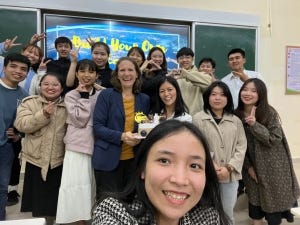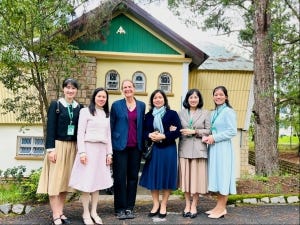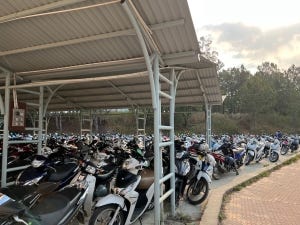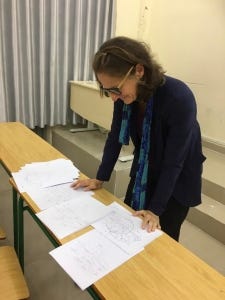Preparing our students to build a new world
On the first day we talked about clouds. I needed a hook, and, given the abundance of different cloud types one can observe in the city of Dalat in a day (sometimes even in an hour), this seemed like a good place to start a short course on Tropical Meteorology and Climate Change. Who doesn’t like clouds? My first class in Vietnam was not unlike a first class in any of my other courses back home. I had the same objectives: I wanted to know my students. I wanted them to understand what we can expect from each other and from the course. I wanted them to feel excited for what we about to learn together.

The difference between this class and most of my other classes is that I was teaching students who don’t speak English as a first language. This was not the first time I have done this. I have taught Spanish-speakers in English. But being able to speak Spanish myself made it much easier to anticipate how my students might translate what I’m sharing, and it was easy enough to switch to Spanish for a bit if we needed to.
But I do not speak Vietnamese.
Still, within moments of beginning my class at the University of Dalat, I felt quite at home. I shared Powerpoint slides written in English and Vietnamese (thanks to Google Translate) to make sure everyone could follow along. I was also so grateful to have my colleague in Environmental Science, Professor Hau, in the classroom with me. She was able to help out when something didn’t quite translate right, or when students had concerns or questions and didn’t feel comfortable speaking in English.
The students were, in so many ways, similar to the students I teach in Colorado. In every class there are some students who sit up front and are eager to answer and ask questions. There are some students who take notes on computers, some who make neat marks in their notebooks with multi-colored pens, some who just sit and listen, some who are on their phones. There are others who sit in the back and talk in low voices with their friends. I never take offense when it looks like someone isn’t paying attention. I know they are not necessarily disinterested – they just have a lot going on. So, it was comforting on that first day to feel so much familiarity in the classroom.
The course focused on introductory meteorology, and included enough basic atmospheric science to delve into the science of climate change. Just as I would in an introductory class back home, I had students from a wide range of science and engineering majors: biology, environmental science, and agricultural technology, to name a few.
However, despite the familiar feel of the class, the students at the University of Dalat are, in some ways, quite different than my students in Colorado. For example, Vietnamese students ride motorbikes – and they get up early. By 8 am each day, the parking area near the library is a sea of motorbikes. The motorbikes sit like dominos, all leaning to the left, front wheels turned neatly to the side. Some of them are draped with ponchos, and most are adorned with helmets. There is a narrow pathway between the rows where more bikes arrive and search for a place to park. The bikes are the primary mode of transportation for students, and that means that the way people move around, or think about moving around, is very different than what you would find in the US. It’s much easier to navigate narrow, winding streets on a bike than in a car.
The students move from their bikes to class, sometimes walking in groups of 5 or 8, almost always wearing face masks. Usually, in those larger groups, one student will call out a hello to me. I say hello in return, and listen to the giggling as they walk away. Sometimes, if I’m wearing my ‘teacher clothes’ (i.e., a blazer and black pants or skirt), all the students with whom I make eye contact will give a short bow. This is something that takes some getting used to. American students don’t do this.
In class, the students were shy about speaking English, so I tried to bumble through a few words of Vietnamese, and they were eager to help correct me. I learned the words for ‘hot’ and ‘cold’ and ‘Equator’. The word for ‘wind’, and the words for ‘north’ and ‘south’. Words that describe rain and clouds. That is now the extent of my knowledge of Vietnamese, as much as I tried. I’m still not sure I have the tone right on the words that I learned.
Maybe because we set this up as an ‘extracurricular’ class, all the students were eager to learn. But like all students, everywhere, their cell phones were always in hand, and so, as with American students, there were always many things pulling their attention in different directions. Text messages come in at all times. Many of them hold part time jobs, and because our class meeting times changed every week, it was hard for them to shift their work schedules. There were exams for other classes, commitments to family, and if they had any bit of free time, maybe there were social engagements.
I have always felt lucky that I slipped through my undergraduate years of college just before the rise of the internet. Sure, it would have been nice not to have to spend hours in my college library, feeding dimes into the Xerox machine so that I could have copies of articles for a class research project. It would have been convenient to send a quick question to my professor via email, rather than wait outside her office door for 30 minutes, hoping she would show up. There were no smart phones, no social media, no web browsing, no pressures to be part of any digital world that might have existed in 1990. That left a lot of room in my mind for other things – time for nature, time for friends, time to give my studies the attention they needed, time to think about my life.
So, I feel for college students around the world today who are under pressure to be digitally in touch at all times. We wonder why so many of them seem apathetic and disconnected. But I think we all feel that. With so many things pulling us in so many directions, it’s hard to make deep, lasting connections with the things we study, the people we meet, and the world right in front of us.
But to ensure a sustainable future for our civilization, younger people need to be able to establish a real connection with the world around them. Thirty years ago it might have been appropriate to focus college courses on content and memorization of ideas and facts that were helpful to have on the tip of your tongue. But today, because students have all the content they could ever need at the tip of their fingers, engaging them in meaningful ways and helping them learn how to process what they see becomes the most important challenge in the college classroom – especially when we are trying to understand what is happening with Earth’s climate and environment.

This generation of college students faces a unique set of societal and environmental challenges. One of those challenges is to maintain optimism. We all see changes in our communities, our environment, our world every day that can be a bit discouraging – fires rage, temperatures soar, floods occur at unexpected times and places – and through it all, we keep expanding our civilization and we keep digging for more fuel, which is the basis for everything that we build on. Solving our problems requires thinking about thing in a new way – from new perspectives.
I’m inspired by all the students I met this spring. Despite the challenges facing the world, they all have some degree of optimism. They are all studying in majors that will give them the skills they need to have a big impact helping to transition their communities to more sustainable, and more economical, ways of life. This is where they will make difference in the world the we’re all hoping to build together in the face of changing climate and limited resources.
I also attribute that optimism to my amazing Vietnamese colleagues in Environmental Science, who truly care about their students and work so hard to make learning relevant, interesting and fun. We bonded over the challenges we share in helping students learn how to apply basic science (physics, chemistry, math) to environmental problems, and preparing students for what lies ahead as global climate continues to warm.
Across differences in culture, teaching approaches, and language, we are all trying to prepare our students with the skills to build a new world – one where there is enough food, clean water, and energy for everyone. This is what keeps us motivated to do what we do.






